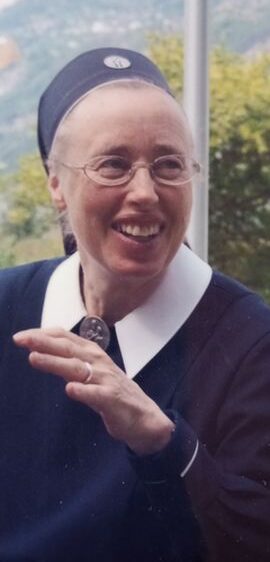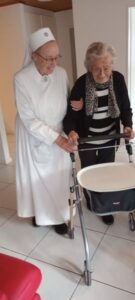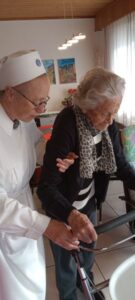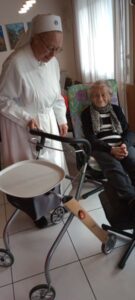Interview with Sister Ruth-Maria Bortis,
Brig, Switzerland – Part 1
Sister Ruth-Maria Bortis worked for almost 20 years as a nursing specialist in Spitex (external hospital assistance and care). Until her retirement, she was affiliated with the Upper Valais Social-Medical Center. Since then, she has been a freelance nurse for 2 years.
Sister Ruth-Maria, you worked at “Spitex” for 18 ½ years–until you retired in 2022. Can you briefly explain what this job entailed?
My job included basic care, treatment care, consultation and advice for people of all ages in need of help at home. This allowed those affected to to return home earlier from a stay in hospital or to remain in their familiar surroundings despite personal restrictions. Office work preparing needs assessments, planning, monitoring work and communicating with the management and the team also required time.
What did you enjoy most of all this work?
Meeting many people gave me the most joy. I appreciated accompanying people on part of their life’s journey and helping them to believe in themselves again and to believe that things would turn out well. It always touched me when I was able to be a light of hope. It was also fulfilling to take people’s worries to God and the Blessed Mother while providing care. Something I particularly enjoyed was providing holistic care – caring for mind, body and soul.
Do you remember a particularly impressive, a particularly joyful, experience?
Before Christmas we once visited a young woman who had recently suffered a stroke. She was paralyzed on one side, could hardly speak, and could only react with her bright eyes. She impressed me very much with her YES to her severe blow of fate, which she accepted in faith.
Another very joyful experience: During the night shift, a daughter called on a Friday evening saying she no longer knew how to care for her father who was receiving palliative care. Normally, we weren’t allowed to accept new patients [on a Friday] as the planning for the weekend had already been completed. I thought about it and promised to visit her anyway. It turned out that with some advice and the plan to return the next day, the problem could be alleviated. Above all, it brought the patient the peace and hope that he and his family needed at the time. His shining eyes were my thanks.
What was a big challenge for you in your work as a nurse?
Digitization a good 20 years ago–starting with a cell phone. Later came the Barmain for recording the time spent with patients, then the Digipen, a kind of ballpoint pen that was downloaded every day and the data could be printed out on paper. The biggest milestone was the launch of the tablet.
Digitalization meant work was planned precisely in terms of minutes and there was much less time for patient care, because the prescribed time included office work. That meant everything was recorded immediately on the tablet, and this meant people were increasingly neglected.
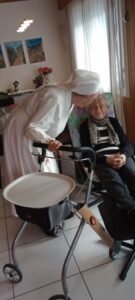
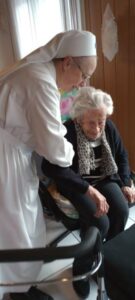
What has changed significantly in Spitex over the years?
In addition to digitalization, I experienced the merger of a small, manageable team with a neighbouring team. Over the years, we expanded again and other areas were added. A very large team was created while, at the same time, the conversation as a team was reduced due to the costs. As a result, the reference to care was increasingly lost.
Working four days meant having a different group every day and working in four different areas. This made it more difficult to build up a relationship with the patients. The prescribed work simply had to be done correctly. It took much [effort] just to look for the patients’ homes and to find our way around.
Now, and already then, you lived in House Schoenstatt with Schoenstatt Sisters of Mary. What does that mean for you? What makes it easier, more difficult?!
Being with other Schoenstatt Sisters of Mary was the greatest gift for me and it meant a great deal to me when I started working here at Spitex 20 years ago. I had a home and a family in the sisters and also in our shrine, which was built during this time. I could always return home, enter the atmosphere of the house and the shrine, and put everything I had absorbed from the people at work into the jug in the shrine, and rest, and recharge my batteries. The sisters supported me by sharing in my everyday life, especially with their prayers. So I was never alone on the road.
At the same time, it was not always easy to find a balance between my job with its working hours and community life, nor was it easy to keep prayer times. It was difficult form e that I wasn’t always able to participate in community life because my work often dictated the rhythm of the day due to the different duties and additional services. On the one hand, I had the experience of belonging to a sisters‘ house and, on the other hand, I was confronted with the outside world, a different world, with its demands. I started anew every day in the shrine. From there I felt sent out to work in the spirit of the sisters‘ family, to fulfill my mission for the people.
Do you have a motto for your work?!
Yes, the sentence by Father Joseph Kentenich that is on my business card:
